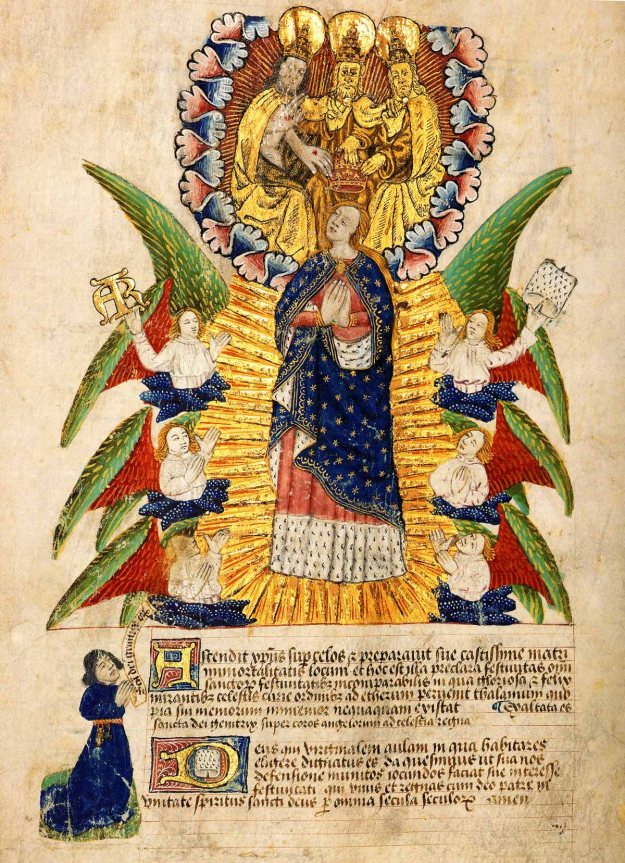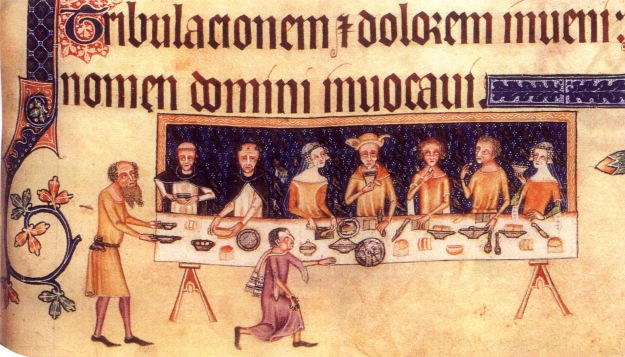The BBC’s new drama series The White Queen began on Sunday. Based on the Cousins’ War novels by Philippa Gregory, the series focuses on Elizabeth Woodville, Edward IV’s queen, who rose to power during a turbulent period of civil war in England known as The Wars of the Roses.
As a medievalist who specialises in this period, I’m delighted that the real life ‘Game of Thrones’ is finally taking attention away from the ever-popular Tudors. Sure, the TV series takes liberties with characterisation and plot – it isn’t for purists who want to learn the facts of the period, see historically accurate clothing, or discover how real medieval people spoke and thought – but it’s a way into some of the complex power relations, family ties and events that typified late fifteenth-century England.
This post is for those wanting to know more about what the real White Queen might have looked like and what she wore in contemporary, or near contemporary, images.
The image of Elizabeth most commonly seen in books and online is that above, one of the three painted panels of her at Queen’s College Cambridge. In the painting, Elizabeth wears a black gown with patterned gold collar and cuffs. The style of her gown is typical of English dresses circa 1475-85. Commonly referred to as a ‘transitional’ dress, it bridges the gap between the V neck Burgundian gowns of the mid to late fifteenth-century and the square-necked early Tudor gowns. The shape of the wide collar is rounded, and it fits over a tight bodice. Her sleeves are tight-fitting with turned back cuffs. Elizabeth has a fashionably high forehead (thought to be beautiful in the Middle Ages) and her hair is pulled back and covered by a truncated henin and cointoise (veil). What looks like an extension of the veil beyond the back of the henin perhaps suggests that it is a butterfly henin, which had structured wires extending from either side to lift the veil higher.
Almost all of the other oil panel paintings of Elizabeth are based on the same image and derive from the sixteenth century, but there are some beautiful contemporary images of the queen in late fifteenth-century manuscripts and stained glass.
In the window of Little Malvern Priory, Elizabeth is shown kneeling in prayer with her family. She wears a blue, fur-collared Burgundian gown with a deep V neck, revealing a golden kirtle and white partlet; accompanying the gown she has a red, ermine trimmed cloak, and a heart-shaped, or horned, headdress, with a padded roll and decorative jewel, matching the decoration on the lectern.
A similar image occurs in Canterbury Cathedral (below). The pious Elizabeth is shown praying opposite her husband, Edward IV, with their children behind them. Her attire is different to that in Little Malvern Priory: here she is crowned and wearing a white and gold patterned gown symbolising purity beneath her purple cloak. A rosary and cross hang down from her belt.
The Luton Guild Book contains another pious image of the royal family, kneeling before Bishop Thomas Rotherham and the Trinity. Elizabeth wears a blue and gold Burgundian gown, with a brown fur collar, partlet, deep green girdle (belt), a purple and ermine trimmed cloak, and a black hood. The women behind her sport butterfly henins.
The purple cloaks in the last two images seem to nod to Elizabeth’s coronation attire, which William Ballard, a fifteenth-century herald, describes as ‘a mantyll of purpull’, that she later exchanges for a ‘surcote of purpull’. She is also shown wearing purple in a miniature in Lambeth Palace MS 265, which shows her brother Anthony Woodville, second earl Rivers, presenting a book to the royal family.
One of the most striking images of Elizabeth is in the Worshipful Company of Skinners’ Fraternity of Our Lady’s Assumption Book, which shows her in a stunning red and ermine trimmed surcoat, and a blue cloak trimmed with gold. As Joanne Laynesmith (née Chamberlayne) has discussed in her work on Elizabeth, medieval queens were traditionally virgins, so Elizabeth’s status as a mother and widow was deeply problematic. Whoever commissioned the image was clearly trying to address her unconventional status and align her with representations of the Virgin Mary: the ideal mother. Elizabeth’s hair is loose (a common way of depicting virgins, especially Mary), she wears a blue cloak associated with purity, and holds an orb and sceptre, just as Mary does in images presenting her as the Queen of Heaven. By constructing Elizabeth’s motherhood in ‘strikingly Marian terms’, the artist distances her ‘from ordinary women’.

Coronation of the Virgin (loose hair and gown similar to Queen Elizabeth’s). Worshipful Company of Skinners’ Book.
Elizabeth wears the same outfit, minus the gold trim on the cloak, and has the same loose hair in one of my favourite manuscripts: Liverpool Cathedral Manuscript Radcliffe 6. Containing the Hours of the Guardian Angel, and still in its original textile binding, this incredible little book has an extremely rare miniature of a presentation scene between two women. The woman presenting the book, almost certainly Joan Luyt, presents the golden Guardian Hours to the queen ‘with euerlastyng ioy’.

Liverpool Cathedral MS Radcliffe 6, Hours of the Guardian Angel. Joan Luyt presents the book to Elizabeth Woodville.
Though Elizabeth’s secret marriage to Edward IV caused great controversy in the 1460s because she fell short of the traditional standard of being an unmarried virgin of considerable status, we would not know this from contemporary depictions of her. The legacy left by the artists that immortalised her in painted glass, parchment and panels, is of a beautiful, powerful and pious individual, who could fulfil the role of mother to all Englishmen. While these images clearly convey an ideal, it’s worth remembering how medieval artists pictured Edward’s bride the next time The White Queen distracts us with inaccurate necklines and zips!












You must be logged in to post a comment.